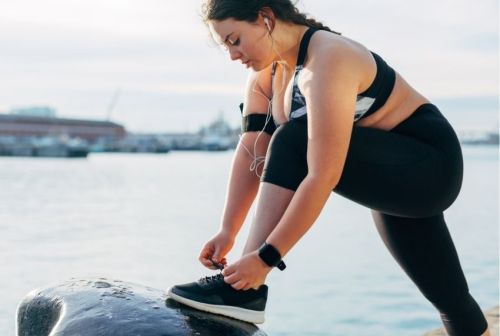If You Have Boob-Related Back Pain, Experts Say Stretching Can Help
If you have upper back pain or any kind of chronic pain from a large chest, it's not because you have “poor posture."

Having large breasts isn’t always easy. They can come with shoulder stiffness, neck aches, or the sense that your back is full of knots. These aches and pains happen because your breasts pull your center of gravity forward. Off-center posture puts additional stress on the muscles that keep you upright, but the good news? Stretching can help relieve upper back pain and prevent it.
Experts in This Article
doctor of physical therapy, owner of Femina Physical Therapy, and author of Sex Without Pain
physical therapist, functional medicine health coach, and owner of Full Circle Wellness PT
Stretches that bring your shoulder blades into retraction are ideal for this kind of pain, Kristen Gasnick, PT, DPT, board-certified doctor of physical therapy at Holy Name Medical Center, says. Moving your muscles can reduce tightness, promote extension, and also feel really good after a long day, and stretching improves blood flow and helps decrease built-up muscle tension.
Below you’ll find six stretches for large breasts, but only attempt these if you are not suffering from an actively injured muscle or spinal injury. Move slowly and breathe deeply as you go to prevent strains or spasms.
Start with some deep breathing
Deep breathing while practicing chest-opening stretches is a 360-degree approach because you’re stretching these tissues from the outside and the inside. Jessica McManus, PT, FAAOMPT, physical and therapist and owner of Full Circle Wellness PT, recommends you lay on your back, and exhale for a count of four or eight, and then inhale for the same amount of time. Imagining that you’re pulling your breath to your feet will help you engage your diaphragm (the strong abdominal muscle below your lungs that supports proper breathing). Deep breathing helps deliver oxygen to your muscles as you stretch and encourages your chest to open up, she adds.
Open Book Stretch
This stretch increases mobility in your mid-spine and ribs. To do this stretch, McManus recommends you lay on your side and extend the arm on top out in front of you. Slowly raise your arm up and over your body. Keep your eyes on your hand, and turn the neck as you go. Imagine your arm is the top cover of a book, and you are opening yourself up. You can hold a small dumbbell to increase the difficulty of this stretch. Try three sets of 15 for this.
Foam Roller Pectoral Stretch
Lay on a foam roller so that it runs straight along your back, McManus recommends. Slowly open your arms and raise them as if you’re making a snow angel. Stop this motion once your arms are almost even with your shoulders and repeat slowly for three sets of 10.
Doorway Chest openers (pectoral stretch)
Stand in a door frame with one elbow up, bending it at a 90-degree angle (think: half a football goal post). “Anchor your forearm on the doorframe, pull your belly button towards your spine to prevent your back from arching, and step forward, leaving your arm behind,” Heather Jeffcoat, DPT, owner of Femina Physical Therapy, says. You should feel a stretch in the front of your shoulder, she says. Hold it for six slow, deep breaths, and repeat on the other side.
Lower Chest Openers (latissimus dorsi stretch)
Stand in a doorway as above, but instead reach your hand up and anchor as high as you can reach on the doorframe, Dr. Jeffcoat recommends. Step forward until you feel a stretch under your arm or down your side. Hold for 5-6 slow, deep breaths. Repeat on the other side.
Thoracic Spine Foam Roller Stretch
Lay on a foam roller and rest it along your bra line. Lace your fingers behind your neck to support your head, and lift your hips to the ceiling, McManus says. Slowly roll your body from the bottom of your rib cage to a couple of inches above your bra line. Drop your head slightly (while supporting it) to stretch the mid-back. Repeat for up to three sets of 10.
If you have upper back pain or any kind of chronic pain from a large chest, it’s not because you have “poor posture.” Gravity is not on your side, and your muscles are tired. Stretching helps you release built-up tension and tightness, Gasnick says.
Experts recommend pairing this routine with some strengthening exercises as well. “It’s important to balance out flexibility in the front with strength in the back,” Dr. Jeffcoat says. “And include core exercises to support the entire torso.”
Oh hi! You look like someone who loves free workouts, discounts for cutting-edge wellness brands, and exclusive Well+Good content. Sign up for Well+, our online community of wellness insiders, and unlock your rewards instantly.
Sign Up for Our Daily Newsletter
Get all the latest in wellness, trends, food, fitness, beauty, and more delivered right to your inbox.
Got it, you've been added to our email list.










